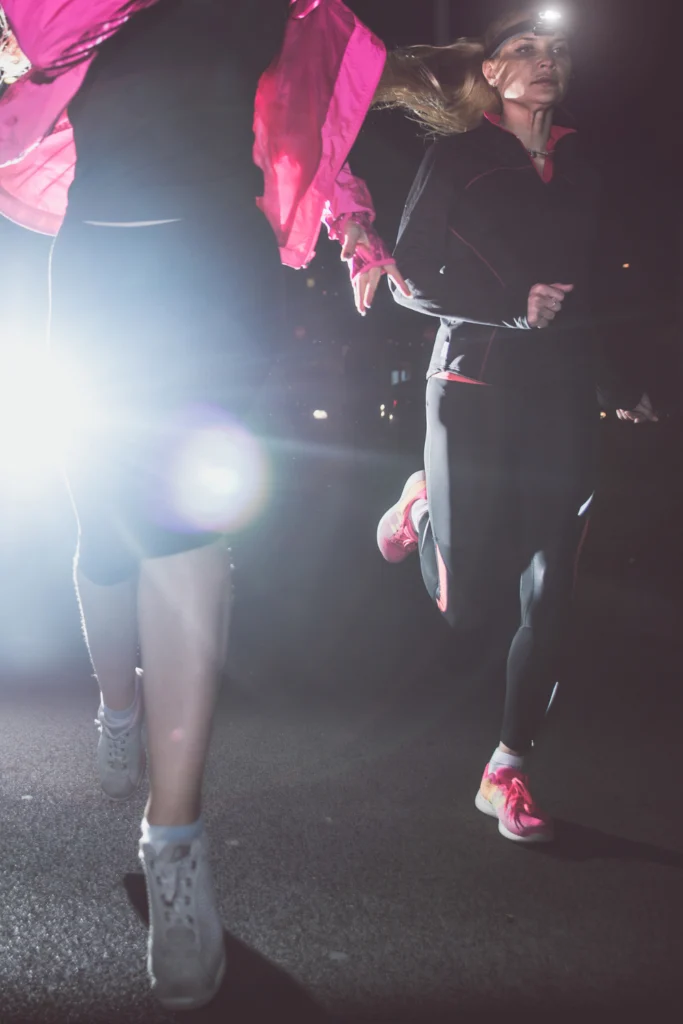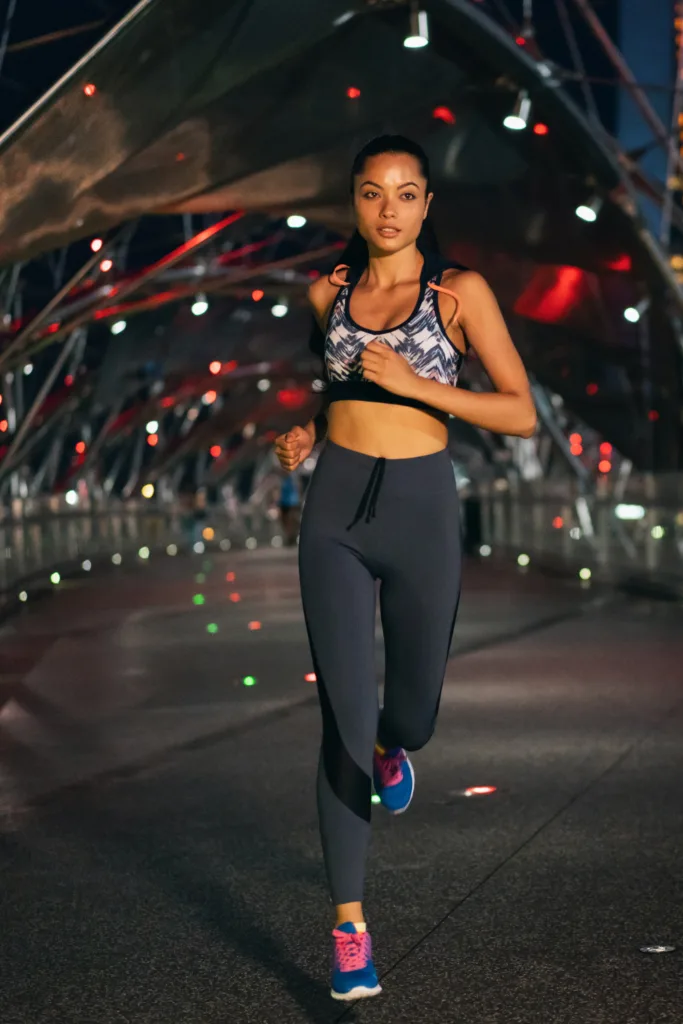It’s that time of the year again – the seasons are changing and the days are unfortunately getting shorter.
This means many runners turn to running at night.
Your morning or evening run, once done in the sparkling sunshine, is now shrouded in darkness.
If you’re lucky, you get the remnants of the day in the form of a beautiful purple sky – one of the best things about running in the Fall (apart of the crunchy leaves, of course).
Running in the darkness can be liberating, and it doesn’t have to be scary if you prepare in advance.
In this guide we’ll explore:
- Is it better to run in the morning or at night?
- Is it bad to workout late at night?
- Night running gear checklist
- 9 safety tips for running at night
Ready?
Let’s go!

Is it better to run in the morning or at night?
Whether you run in the morning or at night is really down to personal preference.
Whilst running in the morning has its benefits, there are also some surprising benefits to running at night.
You’re more likely to run consistently if you run at night because you’re not tempted to snooze through your morning run.
A nighttime run can also help you sleep better, and it also serves as a way to de-stress after a hard day’s work.
Related: 7 actionable tips for running in the morning
Is it bad to workout late at night?
Whilst a late night run is not out of the question, typically health experts have advised against working out late at night because it can stop you from having a good night’s sleep.
According to a 2019 study on the effects of evening exercise on sleep in healthy participants, evening exercise increases rapid eye movement and slow wave sleep and decreases stage 1 sleep.
The study concluded that total sleep time and sleep efficiency might be impaired after vigorous exercise if it is performed at least one hour before bedtime.
The bottom line? Exercising at night can help you achieve a good night’s sleep, as long as you don’t exercise within one hour of your bedtime.
Related: 11 symptoms of overtraining syndrome

Night running gear checklist
Running at night calls for a different set of gear to make sure you stay visible and safe.
Consider investing in the following gear and items:
Reflective clothing
Running clothing that is bright and has reflective fabrics or trims are essential for nighttime runs. This is so motorists, cyclists and pedestrians can see you on your run.
Clothing could take the form of reflective vests, reflective armbands and clip-on reflectors.
Safety lights
Flashing safety lights are becoming more popular with runners who want to be seen when running at night.
Blinking lights stand out more than static reflective materials, so if you’d like that added peace of mind, consider investing in some safety lights.
Many online stores offer lights that can easily attach to your clothing so shop around for the best deals.
Head torch
A bright head torch will help you to navigate the path ahead so you avoid any potholes or any other obstacles that may cause you harm.
You cannot always rely on street lamps to guide you on your run.
Invest in a head torch or a hand-held torch that has at least 200 lumens of brightness.
Related: 7 best websites for affordable running clothes

9 safety tips for running at night
#1 Wear bright and reflective clothing
Don’t think the street lights are enough to keep you visible and seen. This is especially important if you’ll be running on busy roads.
You need to be seen by cars, cyclists and even pedestrians when you’re running at night.
Invest in a high visibility jacket or bib. These can often be found at your local sports store.
#2 Run against traffic
If you have to run on a road for all or part of your run, always run against traffic.
This makes it easier to spot traffic as it nears towards you.
Take extra precautions when approaching junctions as drivers may find it difficult to see you, and always stop and look at road crossings.
#3 Tell someone where and when you’re going
This is good advice for any run, even in the daytime, as it’s always sensible to tell a family member or friend where and when you’ll be running.
For that added peace of mind, take your mobile phone in case you get lost or injure yourself.
You may also consider using a location tracking app.
#4 Plan your route
Plan your running route. This not only gives you that added peace of mind, but also reduces the probability of you getting lost.
Whilst an impromptu adventure is exciting, there’s a time and a place for this, especially at night.
There are plenty of running apps and websites that provide advice on local running routes. Be sure to check that the route is well-lit and in a safe and well-populated area.
Check that it doesn’t have any major obstacles that may be hard to see in the dark. Stick to roads and paved routes where possible.
Pot holes can be nasty things to avoid when you’re running at night.
#5 Wear a head torch
It’s crazy how hard it is to see the path in front of you when you run in the dark.
A head torch helps to identify pot holes and other obstacles. It also helps to shine a light on other things which can often be tricky to see such as road signs and bits and bobs on your pocket or bag.
A good torch will set you back about £10-£15 on websites like Amazon.
They’re surprisingly comfortable once you get used to them on your head.
#6 Limit your use of headphones
At night time, you need to be more alert to the sights and sounds around you, such as traffic and other people.
With music pumping in your ears makes this a lot more difficult, so ditch the headphones for your nighttime runs.
#7 Run with friends
There are plenty of running groups out there that offer free runs in the evening.
Running with friends allows you to have an added set of eyes and ears, and gives you that extra motivation to get out and hit the road.
#8 Consider using a safety app
There are a lot of apps out there that can help to keep you safe on your run, especially if you’re running solo.
These apps provide a whole host of safety features, include location sharing, SOS alarms and alerts.
Here are my top three:
- Glympse – good for real-time location sharing via GPS
- bSafe – good for SOS alarms and location sharing
- Kitestring – good for SMS alerts
Another good idea is to share your location on Whatsapp using the ‘Share live location’ feature.
#9 Consider taking self defence classes
Self defence classes are becoming ever more popular with runners who want to learn how to defend themselves should they get attacked on a run.
Whitney Heins, founder of Mother Runners and VDOT-02 certified running coach shares her best self defence moves for runners.
Heins says: “I want to do all I can to enhance runner safety so we can keep doing this thing that we love by sharing self defence tips for runners”.
In her guide she shares top tips on staying safe as a runner.
- 5 things I wish I’d known before returning to running - March 3, 2024
- Running 20 minutes a day: Benefits + how to start - January 27, 2024
- How to run your first 2 hour half marathon - January 16, 2024
